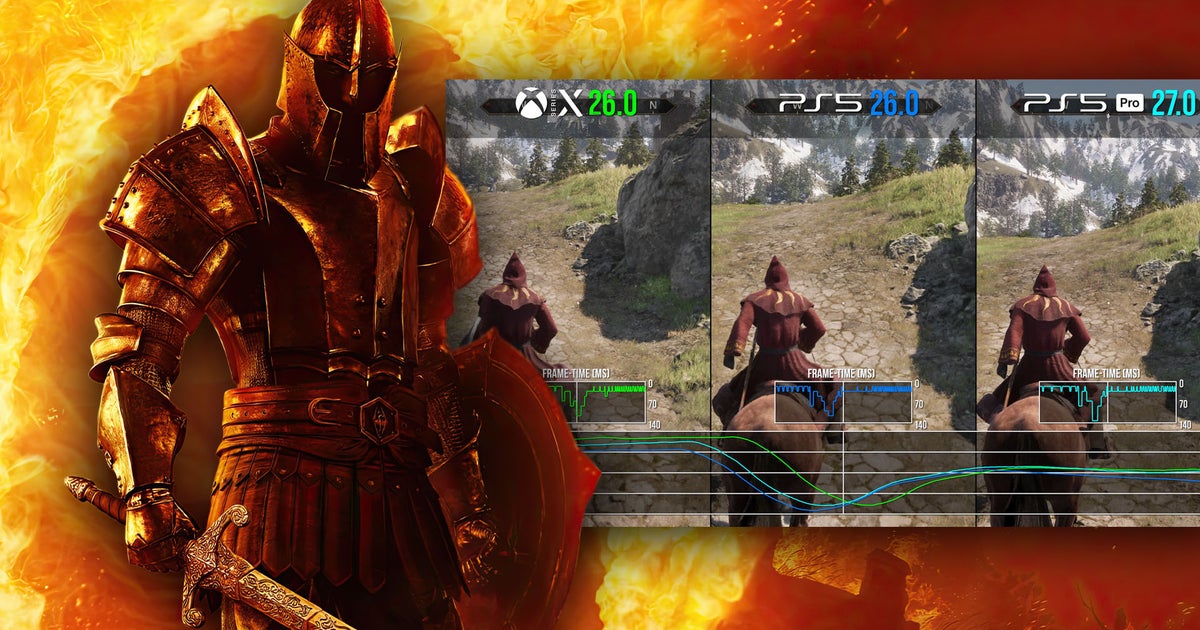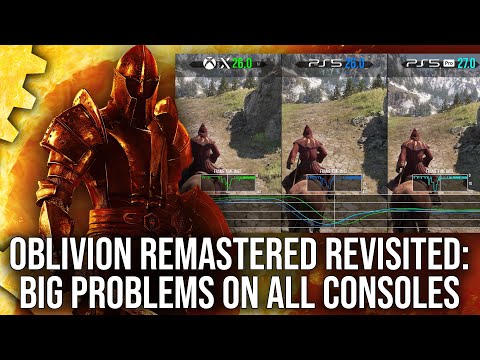Over a fortnight since its launch, the state of the Oblivion Remastered’s performance on console is still a disappointment. The dust has settled on an ambitious, visually striking Unreal Engine 5 overhaul – which is also faithfully running the original Bethesda logic behind the scenes. However, the more we look at the console versions, the more problematic they become. No platform is spared of issues: whether it’s PS5, PS5 Pro or either Xbox Series machine, all struggle with traversal hitches while roaming the open world. Secondly, there’s major sub-60fps frame-rates, where I’ve also discovered that performance slowly degrades with more playing time – quite possibly down to a memory leak. And finally, software freezes are the icing on the cake, with all PlayStation and Xbox platforms crashing to the system menu on loading a save one to many times.
It’s a dire position for any remaster to be in and developer Virtuos needs to address the game’s stability – the crashes – as a priority. Meanwhile, questions need to be asked about the technical QA process: how did the game’s stuttering and performance-related problems make it to launch? There’s the feeling that the game was rushed to market when more time was needed. Also, it’s worth noting that there is still no equivalent hotfix update in place on PS5 or PS5 Pro to match Series X’s version 233550. After giving it some time to appear for our follow-up coverage, it’s seemingly not forthcoming – and so it seemed better that we present the facts as they stand today, with both PS5 machines running on the earlier version 233194. In the end, though, the hotfix has less bearing on the results than expected.
First off let’s address the PS5 Pro upgrade situation. The PlayStation Store suggests that a Pro upgrade is in place and on close inspection, there is a resolution boost over base PS5 and Series X. It’s very much a straightforward bump in pixels pushed by the Pro GPU on both graphics modes, though – performance or quality – and fundamentally there are no other visual changes. Starting with the 60fps performance mode, base PS5 and Series X share the same 1440p resolution target at peak with PS5 often operating at 900p in practise, and Series X typically running at a higher 990p value in matching areas. In this case, PS5 Pro gives us a boost to a higher 1620p target – notably in the inventory screen or simpler dungeons – with drops to 1188p lowest based on my testing. Again, all textures, shadows, world draw, and the quality of the game’s Lumen GI and reflections are identical – and rather, PS5 Pro’s GPU resources are pushed towards more pixels pushed per second.
Switching to the 30fps quality mode it’s the same story, with Sony’s enhanced console offering a further resolution boost. Base PS5 and Series X render at a matching 1620p in the absolute best case, with drops to 1296p at the lower end of the DRS scale. PS5 Pro meanwhile bumps that up to practically a native 4K target – or 3484×2016 in my tests on the inventory screen – which is close enough to suggest a native 4K is theoretically the goal. In practise, of course PS5 Pro is more typically running at numbers like 1584p or 1620p during open world roaming, which is still a sizeable image quality boost over base PS5 and Series X. The potential was there for Virtuos to get more inventive with PS5 Pro upgrades, but it is what it is.
Performance testing is where there are the most glaring problems. Before we kick off, it’s worth stressing that console frame-rates are affected by many factors – like the variable weather, dynamic time of day, NPC and enemy positions, all of which are out of control for exact tests. Surprisingly, 60fps performance also degrades with continuous play time on PS5 and Xbox. For example, a completely fresh boot of the game – that is, closing the software, re-opening it, and loading a save for the first time – gives you an often significantly higher frame-rate when compared to a playthrough that’s been running for 15 minutes or more. Travelling between areas, or cycling through multiple save states, is an easy way to overload the engine and tank performance.
This is true of all console platforms, where matching routes through Cyrodiil’s landscapes run at up to 20 frames per seconds better on PS5 Pro at points, using the fresh boot. Likewise, Xbox Series X and base PS5 have the exact same phenomenon, with a freshly booted save giving consistently higher readings compared to a ‘charged’ playthrough with more continuous play time behind it. Curiously, cycling through saves also introduces bugs in the charged play through: firstly the Lumen GI setting is changed, resulting in thicker shading across the scene at times – which may well explain the performance deficit. And secondly, it leads to the camera position being too high while riding horseback – both of which are fixed by resetting the game.
All of this may suggest a memory management issue. With all of this in mind, a correction is due for my previous console coverage, where I concluded that the hotfix improved Series X’s 60fps performance. On re-testing, it’s likely that the hotfix run only truly benefitted from a fresh boot-up of a ready-made save, while the previous test had more continuous play time behind it. Ultimately, the issue of poor frame-rates remains with or without the latest hotfix update – on PS5 or Series X – and the continuous hours on the clock is the main factor in how the game performs. Supporting the theory that this is a memory management issue – a memory leak, perhaps – is that all consoles crash after a while. After booting the exact same sequence of save points in a row, PS5 and PS5 Pro always freeze at a matching point, taking you to the console front-end. Xbox presents the same issue loading a save, where it bluntly ends the process and takes us to the Xbox menu. Tellingly, re-loading the ‘problem’ save point suddenly works after a fresh boot-up. In summary, crashes may not affect everybody, but this does suggest that time and engagement with the game increases the likelihood of it happening.
Looking at overall performance at 60fps, the fairest approach for comparative testing on PS5, Pro and Series X is to limit the variables – and use fresh boots for every test run. In other words, I reset the game between testing each area on each machine. It’s not indicative of overall performance obviously, as it will eventually degrade, but it’s a more reliable way to get a ground truth of relative performance. First up, the reality is that, as far as traversal hitching goes, it really doesn’t matter which platform you run on. Each has equally sizeable stutters at the exact same points in the world, spiking the frame-time to 100ms or higher. It’s especially disappointing for PS5 Pro. The Pro hardware may be operating with the same CPU limit and so it follows that streaming terrain faces a similar bottleneck – but even if the optional 10 percent clock boost were in place, the results would still be similar. It’s a shame, but this is a constant issue while in the open world, though smaller dungeon areas are less susceptible to hitches.
The second point here relates to general frame-rate readings. Taking long galloping routes towards the citadel, a real performance winner here is hard to pin down – but the point is that all run at between 35 to 60fps. Each console has its moment in the lead, depending on the portion of the test run – which again points to engine variables out of control having a random impact. That being said, base PS5 does turn up with the typically lowest reading,with an average frame-rate of 50fps across the breadth of the run, while Series X and PS5 Pro average at a similar 55fps. It’s hardly what I’d call a victory, as all suffer from major drops to 40fps and under, with sizeable hitches en route as well. What’s clear is that PS5 Pro owners do not get a game-changing performance boost if a solid 60fps is the goal, and even VRR will struggle to mask those hitches. PS5 Pro is better on average next to the base PS5, but fundamentally fraught with the same issues, while its resolution increase is the main enhancement to look out for.


The game’s graphics options menu offers a few alternatives. Switching to the 30fps quality mode, the game runs with a 30fps cap on PS5 and PS5 Pro, with less wavering to the main frame-rate reading in most areas. Sadly, this cap does have frame pacing issues adding judder to camera movement – which is a distraction – and we also have traversal hitches in the same spots as the performance mode. It’s just like Series X, and makes it hard to recommend on either PlayStation console.
Let’s talk about reflections next because as a curious extra there’s also a screen-space reflections toggle on all consoles. This SSR mode is enabled by default and does not affect performance to a measurable extent in our stress tests, given that most drops are caused by traversal streaming. It’s a welcome option to have though: SSR layers over the top of UE5’s Lumen reflections, using a screen-space technique to draw a mirror image. All the usual drawbacks apply, with disocclusion artefacts appearing on water bodies if a weapon overlaps the screen-space, and likewise, it disappears and reappears by looking up and down. Toggling SSR off altogether simply leaves behind the raw Lumen reflection, where the downside of the pure Lumen method is that it’s selective in what it draws. In being dictated by a BVH structure, your proximity to an object is a factor in whether a reflection appears, and you’ll also see pop-in as the appropriate geometry enters that BVH. It’s a distraction that SSR does help to disguise and even though it brings its own issues, it’s recommended to keep SSR enabled.
Returning to Oblivion Remastered for a second round of console testing brings a great many issues to light. This isn’t a PS5 versus Xbox issue; all are affected by hitching, crashes, bugs, major sub-60fps drops, and an uneven 30fps line on quality mode. The chance to revisit with a focus on PS5 consoles only underlines the scale of its issues across a breadth of platforms – and the pressing need for a patch to resolve these profound issues. There’s a lot going here as a celebration of an RPG classic, giving fans old and new a way to enjoy an iconic entry in the Elder Scrolls line. However, the game’s not being done justice when so much technical baggage gets in the way of the experience – and so here’s hoping that a patch update is imminent.

